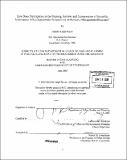| dc.contributor.advisor | Lawrence Susskind. | en_US |
| dc.contributor.author | Peyser, Jennifer Leigh | en_US |
| dc.contributor.other | Massachusetts Institute of Technology. Dept. of Urban Studies and Planning. | en_US |
| dc.date.accessioned | 2006-06-19T17:31:07Z | |
| dc.date.available | 2006-06-19T17:31:07Z | |
| dc.date.copyright | 2005 | en_US |
| dc.date.issued | 2005 | en_US |
| dc.identifier.uri | http://hdl.handle.net/1721.1/33006 | |
| dc.description | Thesis (M.C.P.)--Massachusetts Institute of Technology, Dept. of Urban Studies and Planning, 2005. | en_US |
| dc.description | Includes bibliographical references (p. 115-119). | en_US |
| dc.description.abstract | The conventional environmental impact statement (EIS) decision-making process, governed by the National Environmental Policy Act (NEPA), represents the prevailing practice with regard to public involvement in science-intensive policy disputes. The efficacy of the current system, however, has been widely criticized in terms its methods of public involvement. One shortfall is that, although agencies solicit public input at various points, they do not involve stakeholders in a meaningful way in the scientific work associated with environmental decision-making. In particular, agencies give the public only a small role in framing scientific studies and no role in research interpretation or incorporation of science into decision-making. Further, agencies' attempts to involve stakeholders in technical questions, while well intentioned, are seldom designed in such a way as to maximize legitimacy of the process or credibility of the science used to craft the plan or policy. Joint fact finding is a process by which stakeholders work with scientists and decision-makers to frame, review, and incorporate scientific information into policy decisions. Through literature review and case studies of three approaches to public involvement, joint fact finding is explored as a process with the potential to improve the legitimacy and credibility of environmental assessments. While a broad range of stakeholder views were found, joint fact finding was particularly distinguished from conventional processes by its transparency and the explicit connection of science with policy. Resource management decisions involve not only scientific information but nonobjective judgments and values-based interests. | en_US |
| dc.description.abstract | (cont.) Thus, the involvement of stakeholders in a range of scientific processes, and the linking of scientific information to policy-making, is key to public perceptions of credibility and legitimacy. Based on the literature and cases, a number of minimum conditions for successful public involvement in resource management decisions were identified. Convening a stakeholder group of diverse, self-selected representatives must occur early enough for stakeholders to participate in framing the scientific inquiry. Agencies should recognize, manage, and involve stakeholders in nonobjective judgments inherent in scientific inquiry, and help prepare stakeholders for technical discussions through capacity building activities. Finally, it was found that the use a neutral facilitator can benefit the process, and that stakeholders should be involved in selecting and contracting with a facilitator to ease concerns about agency influence. | en_US |
| dc.description.statementofresponsibility | by Jennifer Leigh Peyser. | en_US |
| dc.format.extent | 119 p. | en_US |
| dc.format.extent | 6842942 bytes | |
| dc.format.extent | 6850391 bytes | |
| dc.format.mimetype | application/pdf | |
| dc.format.mimetype | application/pdf | |
| dc.language.iso | eng | en_US |
| dc.publisher | Massachusetts Institute of Technology | en_US |
| dc.rights | M.I.T. theses are protected by copyright. They may be viewed from this source for any purpose, but reproduction or distribution in any format is prohibited without written permission. See provided URL for inquiries about permission. | en_US |
| dc.rights.uri | http://dspace.mit.edu/handle/1721.1/7582 | |
| dc.subject | Urban Studies and Planning. | en_US |
| dc.title | How does participation in the framing, review, and incorporation of scientific information affect stakeholder perspectives on resource management decisions? | en_US |
| dc.type | Thesis | en_US |
| dc.description.degree | M.C.P. | en_US |
| dc.contributor.department | Massachusetts Institute of Technology. Department of Urban Studies and Planning | |
| dc.identifier.oclc | 61763813 | en_US |
